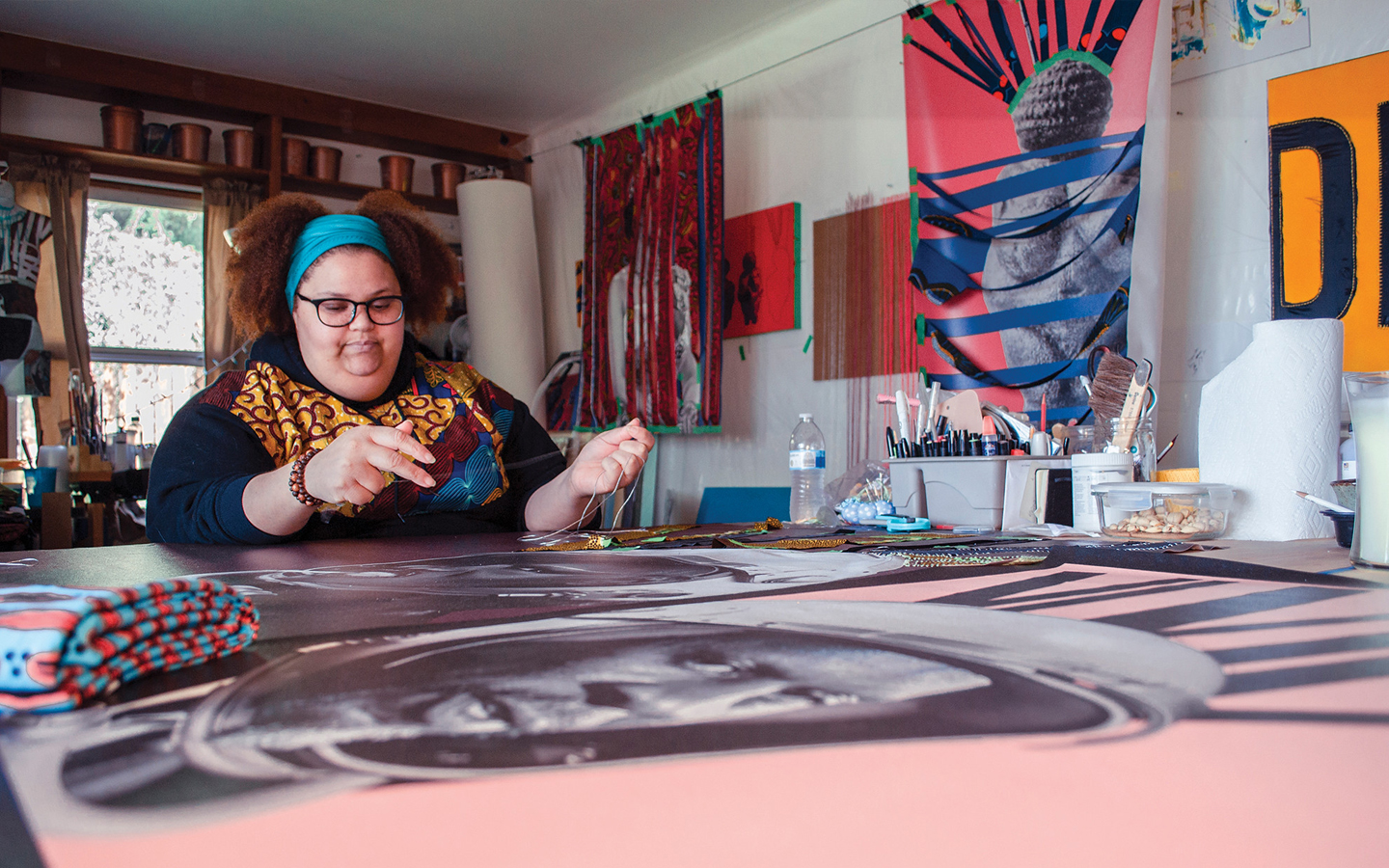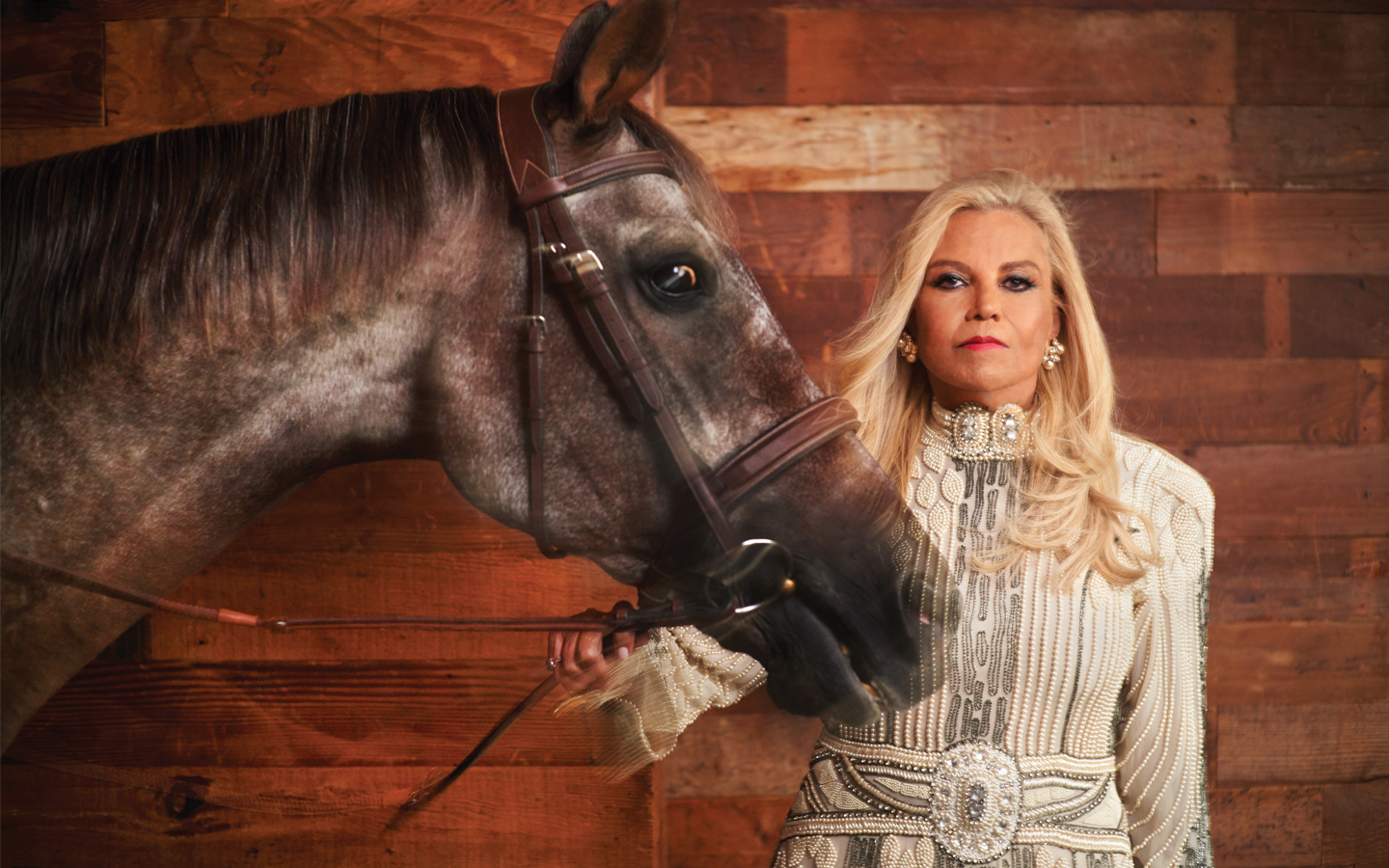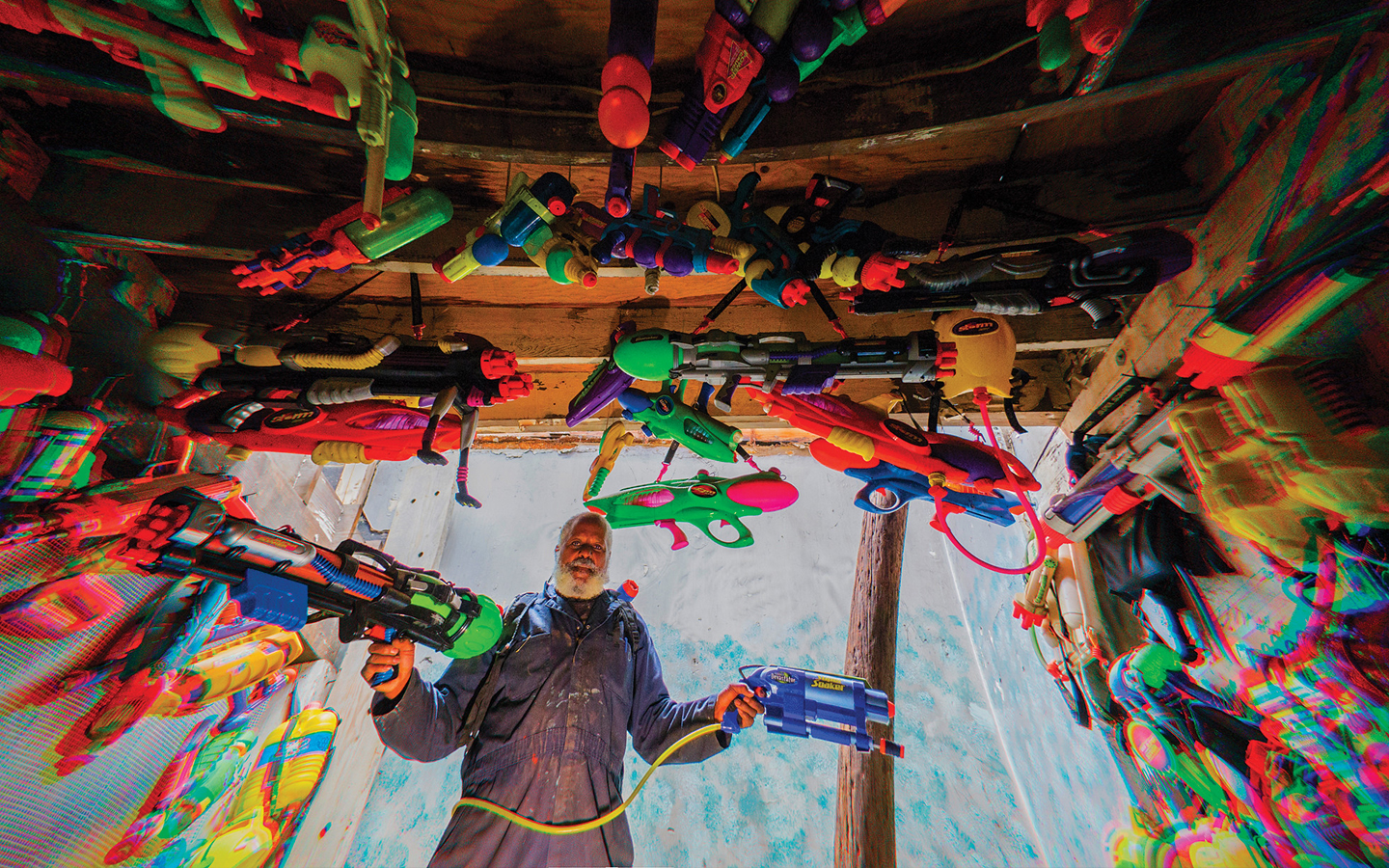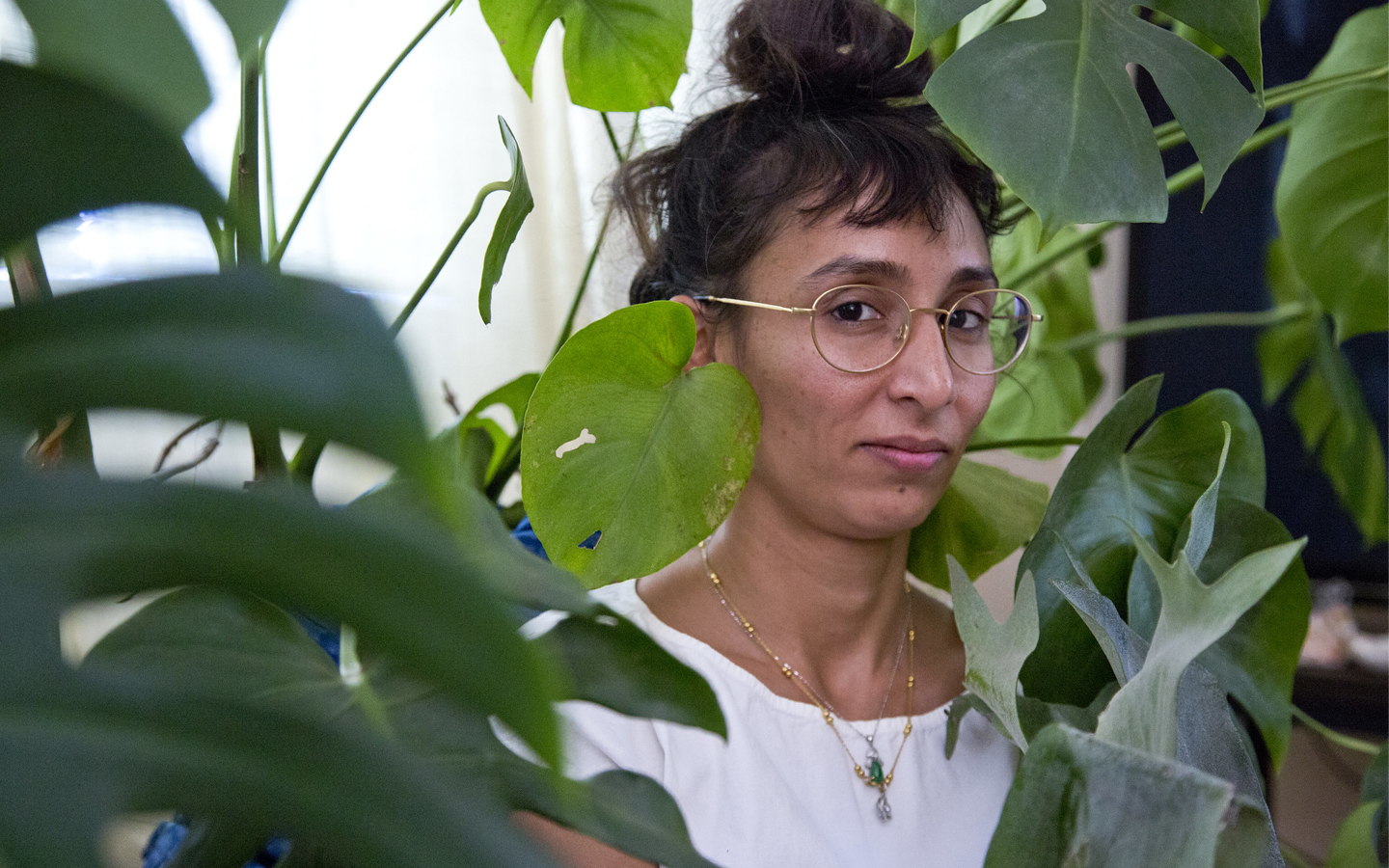
April Bey
TEXT GENIE DAVIS
VISUAL FARIDA AMAR
April Bey is a denizen of Los Angeles, but she grew up in the Caribbean and her art takes her to locations as far flung as West Africa, Iceland, Morocco and Dubai. Her visionary interdisciplinary work turns an introspective and often defiant eye on poignant subjects such as Bahamian popular culture, immigration, generational theory, social media, and Afrofuturism.
If that sounds overwhelming, consider this: along with her work as a contemporary artist, Bey is also a curator and an educator, currently teaching at Glendale Community College. At the Art Center College of Design, she created the controversial curriculum Pretty Hurts, which focuses on a rough and tumble analysis of process-based art and Beyoncé-hashtag-faux-feminism.
Got that? Then get this. As an artist, she describes her approach, message and materials as that of “an interdisciplinary rule-based / process-based artist. I put a lot of research into my work based on travel, collecting and documenting. Material matters in my process: if I’m referencing media or print I become a printmaker. If I’m alluding to gender binaries, I focus on uniquely ‘feminine’ and ‘masculine’ stereotypes and ways of making – sewing, drilling, etc. – and distort them entirely,” she explains. “I come to my work inquisitively, with the hopes of my community and the audience also sharing in the same questions.”
Among her many materials and mediums, Bey works in technology. “I’m a generational theorist. I studied it in academia and have published work on the concepts written about and explored. Coming from that background, I choose to focus on my own generation – Gen-X-leaning Millennials. Social media and the Internet act as a paintbrush, so to speak, for others and myself in my generation.”
Bey is interested in the languages being formed by tech platforms. As an example, she relates, “In Picky Head, I solicited thousands of selfies from people all over the world showing their black natural hair which was included in an installation installed both in The Bahamas, where I’m from, and here in LA at the California African American Museum.”
Pursuing what she terms “the instant gratification collaborative methods that social media and the Internet offer creatives” became a fascination. “I have a background in tech, having worked for Apple, and also coding, bringing in the binary methodologies of technology and how they’re used influences my process and practice,” she says. “Memes have transformed into a relatable and easily accessible language that spans the gaps between gender, race and economic status. My ultimate goal in using technology in my work is to communicate to as many audiences as possible, devoid of elitism and classism.”
When Bey worked on The Millennial Natural Hair Movement, she studied the movement on YouTube, which she saw as “the millennials’ primary source of entrepreneurial endeavors during its Golden Age, which has now passed.”
Technology. “It’s a tool, designed to reach almost everyone. It satisfies my primary goal of spreading the questions I have as an artist to diverse audiences, so it’s essential in most works. I’m also a traveler who is multiracial and multicultural—I find this mosaic way of seeing the world benefits my practice; technology acts as a surrogate to this way of thinking.”
Bey sees as among her most notable works those in which she uses hashtags to communicate to strangers online, as in Picky Head, #WhoDoYouWorship and #Gradient. “The more people the work reaches, the more the work exists; this is the social practice element of my work.”
As an artist, Bey doesn’t feel as if she has a message, or an agenda, per se. “I don’t lecture to my audience, and I don’t feel it’s my job to originate answers or solutions. I ask questions. I present innocent observations and invite the viewer to engage in theories and scenarios with me.” As a general message, she says she would be “continuously seeking knowledge, knowing that we won’t always have the answers, and that in life that’s okay. We are on a constantly shifting scale of nuance.”
Currently, Bey’s work is evolving beyond the United States. “I’m much more interested in what’s happening and being created outside of the LA bubble, and among non-traditional groups, and with innovative narratives. My past works aren’t detached from present day identity though.” Instead, she notes that her works contain threads that are “uniquely Bey, they just mature and re-focus.”
What she most wants people to know about her art is that it “is not here to solve problems, but to ask questions and support inquisitions.” She adds that with her work, viewers can figuratively “take off their shoes, slop some sauce down the front of their shirts and laugh freely with no judgments… they can share their nerdgasms in the same space as their fears and concerns.”
Medium is the message. “The mediums employed in my work represent actual people interviewed and diverse spaces around the world. The process directly relates to the medium.” She adds: “For example, for the Afrofuturist series, I went to six different West African countries interviewing and purchasing knock-off wax fabric from women selling the fabric in the markets.” She notes that the fabric printed in Ghana is too expensive for people to afford. “When brought back to my studio, all materials that interact with this Chinese knock-off fabric must also be MADE IN CHINA. Hand-sewing is employed to reference the actual labor and resilience these women activate in order to sell fabric that meets their cultural aesthetic, but at actual affordable prices.” Her process and material references Chinese Neo-colonialism, which is dominating parts of Africa, and the Caribbean where Bey was raised.
Bey’s latest projects include a solo exhibition, Made in Space, which recently opened at the new, black-owned Band of Vices Gallery in West Adams. “The exhibition is of my new Afrofuturist work that includes fabric collected in West Africa.” She is also participating in an artist residency at the Current Art Studios Baha Mar in Nassau, in the Bahamas. The work produced will be exhibited there in May and June.
She describes Made in Space as “the brand or label we see on clothing and space helmets used by gender- fluid universe travelers focused on anti-colonizing adventures.”
The exhibition includes works from Bey’s Afrofuturist Womanism series, which explores female Afrofuturistic millennial entrepreneurialism via social media and the Internet. That may sound like a mouthful, but the works are accessible, combining popular elements such as Star Trek and hip-hop culture. Bey uses these methods to approach current issues of global race and discrimination through her art.
Using Afrofuturistic memes, Bey explores what she terms the “demands of womanhood,” and tackles the “hypocrisy in the expectations of women, specifically black women, to be sovereign and robust while at the same time inept and emotionally weak/unpredictable when leadership roles are sought.” As with all her work, Bey stresses “material matters and process is essential – the process in all of the work directly emulates the labor women execute on a daily basis to persist. It is uniquely and defiantly ‘feminine,’ executed in aggressively ‘masculine’ ways.” Utilizing sewing, wood, resin, hand-drilling holes; using needles, thread, fabric and needle- threaders that are all low-quality and made in China, her work here is both art and reality, “floating within our self-defined identities…”
Her new work may be titled Made in Space, but it is acutely focused on the hearts and minds of the real world. Her materials matter, and so does the meaning behind them.
You may also like
Suzanne de Passe
Her story has taken on the mantle of myth and legend. It’s been retold in Harvard Business School
Charles Dickson
Charles started making things as a five-year-old child afflicted with asthma, when he became interes
Harpreet Kaur
When Kaur shows us some of her work, she is sure to point out the pieces that she hates. “Even whe




